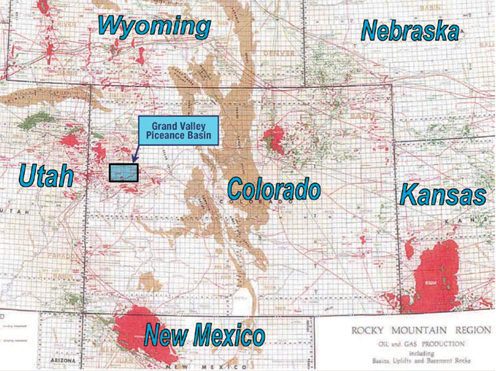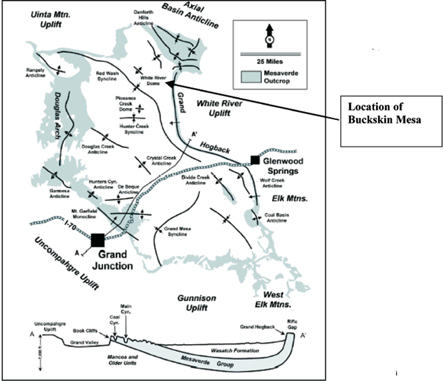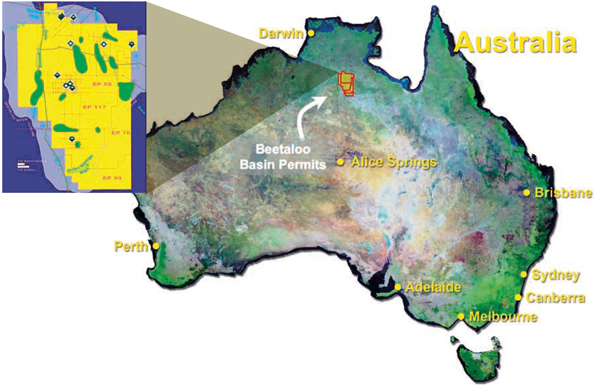Piceance Basin
The Piceance Basin is located in western Colorado along the I-70 corridor between Grand Junction and Glenwood Springs in what is known as the Grand Valley. There are over 6,000 active oil and gas wells in the Piceance Basin. This area has been undergoing a rapid expansion in gas production and exploration due in part to increasing gas prices from 2002 to the present, increased pipeline capacity, and improved technology, which have all contributed to the success of the unconventional Basin Centered Gas Accumulation (BCGA) in the Grand Valley area.

Although the Piceance Basin has been an established producing area for the past twenty years, a combination of low gas prices and technical challenges slowed the exploitation of what geologists classify as an enormous gas potential for several reasons. For example, Rocky Mountain gas prices have suffered due to a lack of export pipeline infrastructure. This gas has typically sold for a couple of dollars per mcf below Henry Hub pricing for the rest of the country. Also, the greatest potential resources are found in unconventional technically challenging deposits, i.e., coalbed methane, tight gas sands, and Basin Centered Gas Accumulations or BCGAs.
Recently, the industry has developed new technologies that allow us to solve these problems and access theses resources at commercially viable rates and quantities. As these conditions are changing, gas production is undergoing a dramatic increase in the Rocky Mountain West. Today, with increased gas prices and constantly improving technology, more and more gas resources are becoming accessible and with them a higher yield of “economic fruit” at lower risk.
Although the Piceance Basin has been an established producing area for the past twenty years, a combination of low gas prices and technical challenges slowed the exploitation of what geologists classify as an enormous gas potential for several reasons. For example, Rocky Mountain gas prices have suffered due to a lack of export pipeline infrastructure. This gas has typically sold for a couple of dollars per mcf below Henry Hub pricing for the rest of the country. Also, the greatest potential resources are found in unconventional technically challenging deposits, i.e., coalbed methane, tight gas sands, and Basin Centered Gas Accumulations or BCGAs.
Recently, the industry has developed new technologies that allow us to solve these problems and access theses resources at commercially viable rates and quantities. As these conditions are changing, gas production is undergoing a dramatic increase in the Rocky Mountain West. Today, with increased gas prices and constantly improving technology, more and more gas resources are becoming accessible and with them a higher yield of “economic fruit” at lower risk.

Buckskin Mesa Prospect
PetroHunter Energy is participating in a large acreage position consisting of some 20,000 acres that have been leased in and around the Buckskin Mesa/Powell Park discovery wells. Gustavson Associates estimates the existing in place potential gas resources* (P50) of all play types within the prospect at nearly 3 TCF of gas with potential recoverable resources of 1.6 TCF
The Buckskin Mesa Project, located in the northeastern Piceance Basin, Rio Blanco County, Colorado, first generated interest in the 1950s due to surface geological features – faults and an anticlinal closure.
* includes recoverable and unrecoverable resources.

Beetaloo Basin, Australia
Basin Centered Gas Prospect
The Beetaloo Basin is located in the Northern Territory of Australia approximately 500 km south of Darwin, and is a giant, under-explored frontier basin that has all the elements of a world-class hydrocarbon system. The basin is unusual in the 21st Century petroleum industry in that it is a very large under-explored basin containing a thick sequence of relatively undeformed Proterozoic age sediments. The basin contains a well-documented oil-prone source rock that has generated oil. Oil of 35°API gravity has been recovered from wells drilled off-structure. A dozen large structural leads have been identified from limited seismic control.
Beetaloo Basin Summary
• 7,000,000 net mineral acres with good access, additional acreage being acquired (PetroHunter owns a 50% interest)
• Oil-prone source rocks that have generated billions of BBLS of oil
• Indications of a large BCGA
• Multiple conventional plays for oil and gas
• Large untested structures, adequate reservoir quality, thick pays
• Large seismically defined structural traps at 1,500 - 3,000 meters
• Geologists believe opportunity exists for large reserves
• High risk, modest failure costs, with high potential

Petroleum geologists who have studied the basin believe it exhibits the following characteristics:
• potential for a significant unconventional play types, especially tight
gas and/or Basin Centered Gas Accumulations. The unconventional
BCGA resources are described as follows (Ben Law, An Assessment of
Basin Centered Gas in the Beetaloo Basin, Northern Territory,
Australia, 2005, proprietary report):
• multiple conventional plays for oil and gas
• truncation and stratigraphic trap potential is highly probable but as yet unidentified
The most likely estimates of recoverable gas in the Moroak and Bessie Creek Sandstones are calculated to be 11.2 and 17.5 trillion cubic feet (Tcf) respectively. These estimates are based on a well spacing of 160 acres and 10% recovery from a calculated most likely, in-place gas resource of 119 Tcf in the Moroak Sandstone and 174.9 Tcf in the Bessie Creek Sandstone. The large gas estimates re-flect the nature of BCGA accumulations. Additional gas, interpreted to be present in the Velkerri Formation source rock was not assessed, but could be significant based upon BCGA experience in the U.S.
Licensing terms are very attractive and Australia has highly favorable political and fiscal regimes. Infrastructure in the form of national highways, railroad, and a gas pipeline run through the acreage, affording access to local and international markets.
The assessment of the Beetaloo Basin is that the technical risk is high at this stage of exploration and that the potential reward is also very high. PetroHunter owns an undivided 50% working interest in the Beetaloo exloration permits, and will say the first $100 million of combined MAB/PetroHunter project costs. Thereafter, each Party pays its proportionate 50/50 share.


